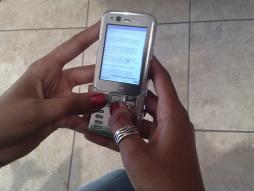Jonathan Donner, Kentaro Toyama, and I recently wrote a paper -- "Reflections on the M4D Landscape" -- in which we critically examine the current diversity of projects and approaches in M4D.
We identify four common choices facing individual projects in mobiles for development: who are the intended users, how technically accessible the solution is, whether the project links to other platforms or content, and what the project requires from handset manufacturers and operators.
We think that these choices collectively mark aspects of the current landscape of M4D. We also think that these choices made at the project level may create different M4D landscapes with implications for the breadth and depth of the technology’s impact on development.
The current discussions of M4D projects have typically tended to be delineated by traditional development domain such as health, education, agriculture, etc. We think that by focusing on choices that cut across domains, we highlight elements which vary across M4D projects, but which to date have not been observed to correlate with project success.
We chose as a sample the 36 projects that were represented at MobileActive08 as a subset of projects to investigate. We are particularly curious about the extent to which these choices can be correlated with the success of individual M4D projects.
What did we find? At this early experimental stage, none of the four choices which we have highlighted have ‘right’ answers—individual projects seem as likely to succeed with almost any configuration. That said, there are significant biases within this (admittedly non-randomly chosen sample) towards projects that required no dependency on other information sources or explicit cooperation from operators. This likely reflects the relative ease of deploying such projects.
We think that one fruitful path for future research would be to assess the relative success of M4D projects making each of the choices outlined in this paper. It is certainly possible that such research would be able to isolate the impacts of discrete choices—finding perhaps that niche applications yield greater development impact than general applications, or that projects with operators’ support outperform similar independent applications. However, it is more probable that these choices are too interdependent, and too context-specific, to be broken down so easily. Om that case, future research designs could instead examine whether different combinations of choices are associated with success.
Put another way, further research might try to isolate modalities or clusters of choices among successful M4D projects. For example, we might find one mode of ‘mass’ applications which work closely with operators or handset manufactures and work well on low-end phones, while another configuration might consist of projects targeting niche users, on smartphones, drawing on hybrid content, but without the engagement of operators or handset manufacturers. The identification of these clusters would improve the discussion of ‘best practices’ in M4D.
Secondly, although the data is not available at this stage to associate any of these four choices with the success of individual projects, we can imagine impacts on the aggregate M4D landscape. Essentially, we can describe how multiple micro-level projects might drive macro-level outcomes. For example, the choices across hundreds of projects to address low-end phones, vs. mid-range-feature phones, vs. high-end smartphones will shape the degree to which the world’s poor will be able to benefit directly from M4D projects. Although the proportion of feature-rich handsets in use continues to rise, tens or hundreds of millions of the current ‘dumb’ handsets will remain in service for a long time it is important for the M4D community to remain cognizant of what phones its various target communities are likely to carry.
Similarly, on the matter of content, it is important for the M4D community to build links between the content it generates and the broader worlds of community, national, and global content available on the internet and on other information sources. If individual projects choose to pursue “standalone” content there is of course no harm done, but as a whole, an environment with lots of applications and projects which link low-end handsets to the internet and to other media will be more diverse and probably richer than one which creates second-class information users and sources. We’re intrigued by applications and projects which seek to leverage other sources and reduce differences between information ‘haves’ and ‘have-less.’
Finally, this is only a tentative and limited beginning of what should be a much longer and more thorough exploration of M4D projects and their success, characteristics, and positioning in the larger landscape. We are looking forward to extending this work, and incorporating additional aspects of a deveoping m4d taxonomy.
"Reflections on the M4D Landscape" was presented at the first M4D conference in Karlstad, Sweden.


Post new comment